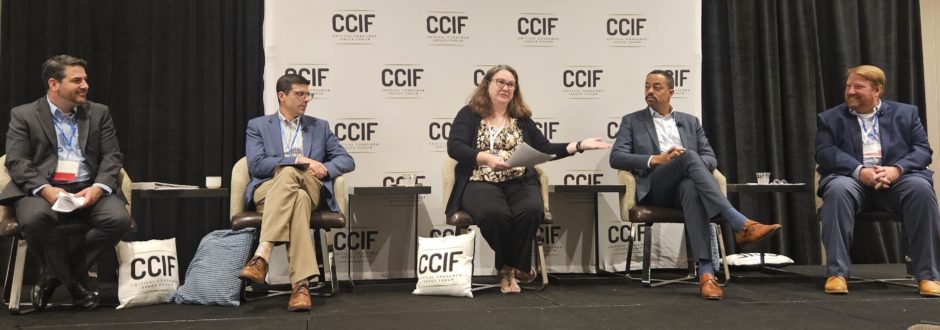Investments in distribution grid security and resilience measures can reduce the impact of, and facilitate recovery from, major incidents such as storms or cyber attacks; however, the level of such investment must be carefully considered in light of both the benefits and costs to the system and to electric customers. Additionally, technologies such as the Internet of Things (IoT), microgrids, and energy storage increasingly are being integrated into the distribution grid. These technologies may enhance security and resilience at the distribution level, but they also may present challenges. Leadership of the Critical Consumer Issues Forum (CCIF) recognized a need for its three core groups—state regulators, consumer advocates, and energy companies—to come together to compare experiences, share lessons learned, and propose ideas concerning these complex issues and their potential impacts on electric customers and the energy grid.
In response, CCIF formally began its dialogue on these issues in November 2017 in Baltimore during its annual Kickoff Forum. Over a series of spring summits that followed, participants shared a great deal of information and resources, much of which is featured in this report. Summit participants also worked together to develop the 25 consensus principles that we hope will spur additional dialogue and other positive outcomes in the local, state, and federal arenas.
The principles and featured information are divided into the following three sections of the report:
- Security – Physical and Cyber. In the first section, principles recognize that the increasingly interconnected distribution grid must be secured sufficiently—ideally to prevent, but in any event, to recover from, physical and cyber security incidents.
- Distribution Grid Resilience. In this section, CCIF highlights important considerations in the process of making the distribution grid more resilient.
- Integrating Technologies at the Grid Edge. The principles in this section call for balanced regulatory and policy approaches that allow benefits to be realized while customers are adequately protected and the grid is reliably and securely maintained.
CCIF trusts that the valuable perspectives reflected within this report will prove instrumental in building upon these ideas through further constructive dialogue among state regulators; consumer advocates; energy companies; leaders at the local, state, and federal levels; and the broader stakeholder community. Given the continuing importance of issues pertaining to resilience, security, and the integration of technologies at the distribution grid’s edge, CCIF encourages—and may initiate—additional discussion related to these topics in the future.
CCIF’s July 2018 report on these issues,
Investments in distribution grid security and resilience measures can reduce the impact of, and facilitate recovery from, major incidents such as storms or cyber attacks; however, the level of such investment must be carefully considered in light of both the benefits and costs to the system and to electric customers. Additionally, technologies such as the Internet of Things (IoT), microgrids, and energy storage increasingly are being integrated into the distribution grid. These technologies may enhance security and resilience at the distribution level, but they also may present challenges. Leadership of the Critical Consumer Issues Forum (CCIF) recognized a need for its three core groups—state regulators, consumer advocates, and energy companies—to come together to compare experiences, share lessons learned, and propose ideas concerning these complex issues and their potential impacts on electric customers and the energy grid.
In response, CCIF formally began its dialogue on these issues in November 2017 in Baltimore during its annual Kickoff Forum. Over a series of spring summits that followed, participants shared a great deal of information and resources, much of which is featured in this report. Summit participants also worked together to develop the 25 consensus principles that we hope will spur additional dialogue and other positive outcomes in the local, state, and federal arenas.
The principles and featured information are divided into the following three sections of the report:
- Security – Physical and Cyber. In the first section, principles recognize that the increasingly interconnected distribution grid must be secured sufficiently—ideally to prevent, but in any event, to recover from, physical and cyber security incidents.
- Distribution Grid Resilience. In this section, CCIF highlights important considerations in the process of making the distribution grid more resilient.
- Integrating Technologies at the Grid Edge. The principles in this section call for balanced regulatory and policy approaches that allow benefits to be realized while customers are adequately protected and the grid is reliably and securely maintained.
CCIF trusts that the valuable perspectives reflected within this report will prove instrumental in building upon these ideas through further constructive dialogue among state regulators; consumer advocates; energy companies; leaders at the local, state, and federal levels; and the broader stakeholder community. Given the continuing importance of issues pertaining to resilience, security, and the integration of technologies at the distribution grid’s edge, CCIF encourages—and may initiate—additional discussion related to these topics in the future.
CCIF’s July 2018 report on these issues, Security & Resilience at the Distribution Level: Integrating Technologies at the Grid Edge, may be downloaded here.
CCIF’s July 2020 report, Planning for the Electric System of the Future: The Path to a More Resilient Energy Grid, may be downloaded here.
